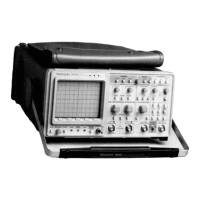Current limiting for the +15 V supply is provided by the
internal circuitry of the three-terminal regulator. Diodes
CR576 and CR583 protect U570A from transient voltage
reversals.
Resistors R576 and R575 at the regulator output divide
the +15 V level down for comparison to the +10 V refer-
ence applied to pin 3 of operational amplifier U570A. At
initial power up, when the input voltage at pin 2 (from the
divider) is lower than the
+
10 V reference, the output of
amplifier U570A is high, and the output voltage is allowed
to rise. As the regulator output reaches +15 V, the
amplifier begins sinking current away from the reference
pin of the three-terminal regulator via diode CR575. This
sets the voltage on the reference pin at its nominal level
and holds the output at +15 volts.
+
15V Regulator
The +15 V Regulator uses three-terminal regulator
U579 and operational amplifier U570A (arranged as the
voltage sensor) to achieve regulation of the +15 V sup-
ply). The three-terminal regulator holds its output voltage
on pin 2 at 1.25 V more positive than the reference input
level applied to pin 1. The voltage at the reference pin is
established by current in diode CR575 and is controlled by
voltage sensor U570A.
Operational amplifier U170B and its associated com-
ponents make up a -5 V Reference circuit used as the
reference for the negative regulators. It is configured as an
inverting amplifier with a gain of 1/2 and converts the
+10 VREF input to a precision - 5 VREF output.
Resistor R556 and capacitor C664 form an RC filter
network that smooths the unregulated +15 VA supply
before it is applied to voltage-reference IC U180. The +10
volt output from pin 6 of U180 feeds a low-pass filter com-
posed of R900 and C900. The output of this filter in turn
feeds unity-gain buffer amplifier U90a, the output of which
is the source of the +1a V reference used by the various
positive regulators. Low-pass filter R900-CgOO provides
filtering for the IC voltage reference and provides for a
well-defined voltage rise of the +10 VREF voltage at
power-up.
reference level. In order to maintain a stable supply volt-
age, the reference voltage must itself be highly stable. The
circuit composed of U180, U170B, U900, and associated
components produces the two reference levels used by the
regulator circuits.
3-96
+
10V and -5 V References
Each of the power supply requlators controls its respec-
tive output by comparing the output voltage to a known
The Low-Voltage Regulators (diagram 23) remove ac
voltage noise and ripple from the various unregulated de
supply voltages. Each regulator output is automatically
current limited if the output current exceeds the require-
ments of a normally functioning instrument. This limiting
prevents any further component damage.
LOW-VOLTAGE REGULATORS
Rectifiers
The Rectifiers convert the alternating currents from the
secondary windings of the Inverter output transformer to
the various unregulated dc voltages required by the instru-
ment. Rectification is done by conventional diode rectifier
circuits, and filtering is done by conventional LC networks.
Since resistors R516 and R518 are large compared to
the impedance of the primary winding in T415, the
transformer operates in a current-driven mode. The sec-
ondary winding of T415 is connected to a transresistance
amplifier stage consisting of U170A, C483, and R483. This
amplifier presents a very low impedance to the output of
the transformer and maintains the integrity of the line volt-
age signal representation. Capacitor C483 provides a
negative-feedback path to high frequencies (relative to
60 Hz) and reduces noise on the line-frequency signal. The
output of the transresistance amplifier drives the oscillo-
scope trigger circuitry.
Line Trigger
The Line Trigger circuit, made up of T415, U170A, and
the associated components, provides a representation of
the input line signal to the Trigger stage that is isolated
from the power-line environment.
When instrument power is turned off, the rectified line
voltage begins dropping. At about 178 V, comparator
U834 switches off the LED in U264, and the LINE UP sig-
nal goes LO. A LO output tells the System ItP that power
is dropping, and the ILP begins shutting the instrument
down in an orderly fashion before the secondary voltages
go out of regulation.
signal HI. Through the PWRUP signal circuitry, a HI LINE
UP signal tells the System ILP that ample line voltage is
available for normal instrument operation.
Theory of Operation-2430 Service

